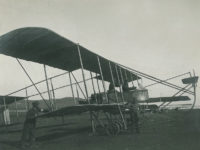The Farman M.F.7 was one of the civil aircraft of the Farman company, which had to be converted into military reconnaissance aircraft at the outbreak of the First World War.
Development and construction:
In 1911 Maurice Farman designed a biplane with wings of different lengths. In between was the open nacelle, which was attached to the struts and wires on the lower wing, in which two people could be accommodated.
The aircraft was equipped with a pusher propeller engine with an initial output of 70 HP, which was replaced by more powerful engines in the years to come.
The chassis consisted of double pairs of wheels which were attached to a skid frame. The horizontal stabilizer, which protruded far to the front, was attached to this frame, which was not only characteristic of this aircraft but also earned it the nickname "Longhorn".
The model was presented for the first time in 1913. Due to its flight characteristics, it proved to be quite successful commercially and established the Farman company as a well-known aircraft manufacturer in France.
In addition to production in France, the aircraft was also manufactured under license in Great Britain.
Use in the First World War:
When the First World War broke out in Europe, the French Air Force urgently needed aircraft. For this reason, she bought the M.F.7 aircraft that had already been built from the Farman company and ordered additional models in order to be able to meet the demand at least in the short term.
On the western front, the M.F.7 aircraft were used exclusively as reconnaissance aircraft due to their light construction and poor performance. Attempts were made to use the aircraft as bombers, but because of the very low payload, they were quickly discontinued.
Already at the end of 1914 and beginning of 1915 the planes began to be withdrawn from the front, exchanged for newer planes and then used for training new pilots.
Technical specifications:
| Description: | Farman M.F.7 |
| Country: | France |
| Type: | Reconnaissance plane |
| Length: | 12,00 meters |
| Span: | 15,50 meters |
| Height: | 3,45 meters |
| Weight: | 580 kilograms empty |
| Crew: | Max. 2 |
| Engine: | an air-cooled 8-cylinder in-line Renault engine, 70 HP (51 kW) |
| Maximum speed: | 95 kilometers per hour |
| Range: | Max. 3 hours and 15 minutes |
| Armament: | no |
This post is also available in:
 Deutsch (German)
Deutsch (German)  Français (French)
Français (French)  Italiano (Italian)
Italiano (Italian)  简体中文 (Chinese (Simplified))
简体中文 (Chinese (Simplified))  Русский (Russian)
Русский (Russian)  Español (Spanish)
Español (Spanish)  العربية (Arabic)
العربية (Arabic)














